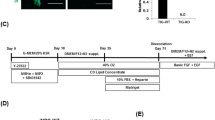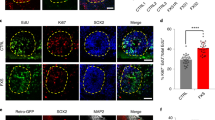Abstract
Transcriptional and proteomics analyses in human fragile X syndrome (FXS) neurons identified markedly reduced expression of COMT, a key enzyme involved in the metabolism of catecholamines, including dopamine, epinephrine and norepinephrine. FXS is the most common genetic cause of intellectual disability and autism spectrum disorders. COMT encodes for catechol-o-methyltransferase and its association with neuropsychiatric disorders and cognitive function has been extensively studied. We observed a significantly reduced level of COMT in in FXS human neural progenitors and neurons, as well as hippocampal neurons from Fmr1 null mice. We show that deficits in COMT were associated with an altered response in an assay of dopaminergic activity in Fmr1 null mice. These findings demonstrate that loss of FMRP downregulates COMT expression and affects dopamine signaling in FXS, and supports the notion that targeting catecholamine metabolism may be useful in regulating certain neuropsychiatric aspects of FXS.


Similar content being viewed by others
Data Availability
The datasets used and/or analyzed during the current study are obtained from Utami et al., Biol Psych, 2020 (GEO (Gene Expression Omnibus) ID GSE117248 and ProteomeXchange consortium ID: PXD011630.
Abbreviations
- FXS:
-
Fragile X syndrome
- hPSC:
-
Human pluripotent stem cells
- hESC:
-
Human embryonic stem cells
- NPC:
-
Neural progenitor cells
- SNPs:
-
Single-nucleotide polymorphism
References
Araki, H., Yamamoto, T., Kobayashi, Y., Futagami, K., Kawasaki, H., & Gomita, Y. (2002). Effect of methamphetamine and imipramine on cerebral ischemia-induced hyperactivity in Mongolian gerbils. Japanese Journal of Pharmacology, 88(3), 293–299.
Ascano, M., Mukherjee, N., Bandaru, P., Miller, J. B., Nusbaum, J. D., Corcoran, D. L., et al. (2012). FMRP targets distinct mRNA sequence elements to regulate protein expression. Nature, 492(7429), 382–386.
Babovic, D., O’Tuathaigh, C. M., O’Sullivan, G. J., Clifford, J. J., Tighe, O., Croke, D. T., et al. (2007). Exploratory and habituation phenotype of heterozygous and homozygous COMT knockout mice. Behavioural Brain Research, 183(2), 236–239.
Bowers, M. E., Buzzell, G. A., Salo, V., Troller-Renfree, S. V., Hodgkinson, C. A., Goldman, D., et al. (2020). Relations between catechol-O-methyltransferase Val158Met genotype and inhibitory control development in childhood. Developmental Psychobiology, 62(2), 181–190.
Craddock, N., Owen, M. J., & O’Donovan, M. C. (2006). The catechol-O-methyl transferase (COMT) gene as a candidate for psychiatric phenotypes: Evidence and lessons. Molecular Psychiatry, 11(5), 446–458.
Crawford, H., Scerif, G., Wilde, L., Beggs, A., Stockton, J., Sandhu, P., et al. (2021). Genetic modifiers in rare disorders: The case of fragile X syndrome. European Journal of Human Genetics, 29(1), 173–183. https://doi.org/10.1038/s41431-020-00711-x
Darnell, J. C., Van Driesche, S. J., Zhang, C., Hung, K. Y. S., Mele, A., Fraser, C. E., et al. (2011). FMRP stalls ribosomal translocation on mRNAs linked to synaptic function and autism. Cell. https://doi.org/10.1016/j.cell.2011.06.013
Davidson, M., Sebastian, S. A., Benitez, Y., Desai, S., Quinonez, J., Ruxmohan, S., et al. (2022). Behavioral problems in fragile X syndrome: A review of clinical management. Cureus. https://doi.org/10.7759/cureus.21840
Dempster, E. L., Mill, J., Craig, I. W., & Collier, D. A. (2006). The quantification of COMT mRNA in post mortem cerebellum tissue: Diagnosis, genotype, methylation and expression. BMC Medical Genetics, 7, 1–7.
Ding, Q., Sethna, F., & Wang, H. (2014). Behavioral analysis of male and female Fmr1 knockout mice on C57BL/6 background. Behavioural Brain Research, 271, 72–78. https://doi.org/10.1016/j.bbr.2014.05.046
Gogos, J. A., Morgan, M., Luine, V., Santha, M., Ogawa, S., Pfaff, D., et al. (1998). Catechol-O-methyltransferase-deficient mice exhibit sexually dimorphic changes in catecholamine levels and behavior. Proceedings of the National Academy of Sciences of the USA, 95(17), 9991–9996.
González-Castro, T. B., Hernández-Díaz, Y., Juárez-Rojop, I. E., López-Narváez, M. L., Tovilla-Zárate, C. A., & Fresan, A. (2016). The role of a catechol-O-methyltransferase (COMT) Val158Met genetic polymorphism in schizophrenia: A systematic review and updated meta-analysis on 32,816 subjects. NeuroMolecular Medicine, 18(2), 216–231.
Gothelf, D., Law, A. J., Frisch, A., Chen, J., Zarchi, O., Michaelovsky, E., et al. (2014). Biological effects of COMT haplotypes and psychosis risk in 22q11.2 deletion syndrome. Biological Psychiatry, 75(5), 406–413. https://doi.org/10.1016/j.biopsych.2013.07.021
Hagerman, R. J., Berry-Kravis, E., Hazlett, H. C., Bailey, D. B., Moine, H., Kooy, R. F., et al. (2017). Fragile X syndrome. Nature Reviews Disease Primers, 3, 1–19.
Li, M., Shin, J., Risgaard, R. D., Parries, M. J., Wang, J., Chasman, D., et al. (2020). Identification of FMR1-regulated molecular networks in human neurodevelopment. Genome Research, 30(3), 361–374.
Ma, J., Zhao, M., Zhou, W., Li, M., Huai, C., Shen, L., et al. (2020). Association between the COMT Val158Met polymorphism and antipsychotic efficacy in schizophrenia: An updated meta-analysis. Current Neuropharmacology, 19(10), 1780–1790.
Maurin, T., Lebrigand, K., Castagnola, S., Paquet, A., Jarjat, M., Popa, A., et al. (2018). HITS-CLIP in various brain areas reveals new targets and new modalities of RNA binding by fragile X mental retardation protein. Nucleic Acids Research, 46(12), 6344–6355.
Pálmason, H., Moser, D., Sigmund, J., Vogler, C., Hänig, S., Schneider, A., et al. (2010). Attention-deficit/hyperactivity disorder phenotype is influenced by a functional catechol-O-methyltransferase variant. Journal of Neural Transmission, 117(2), 259–267.
Papaleo, F., Crawley, J. N., Song, J., Lipska, B. K., Pickel, J., Weinberger, D. R., et al. (2008). Genetic dissection of the role of catechol-O-methyltransferase in cognition and stress reactivity in mice. The Journal of Neuroscience, 28(35), 8709–8723.
Soeiro-De-Souza, M. G., Stanford, M. S., Bio, D. S., Machado-Vieira, R., & Moreno, R. A. (2013). Association of the COMT met158 allele with trait impulsivity in healthy young adults. Molecular Medicine Reports, 7(4), 1067–1072.
Tammimäki, A., Käenmäki, M., Kambur, O., Kulesskaya, N., Keisala, T., Karvonen, E., et al. (2010). Effect of S-COMT deficiency on behavior and extracellular brain dopamine concentrations in mice. Psychopharmacology (berl), 211(4), 389–401.
Taylor, S. (2018). Association between COMT Val158Met and psychiatric disorders: A comprehensive meta-analysis. American Journal of Medical Genetics Part B, 177(2), 199–210.
Turner, G., & Fragile, X. (1997). Syndrome: diagnosis, treatment and research. Journal of Medical Genetics. https://doi.org/10.1136/jmg.34.5.439
Utami, K. H., Skotte, N. H., Colaço, A. R., Yusof, N. A. B. M., Sim, B., Yeo, X. Y., et al. (2020a). Integrative analysis identifies key molecular signatures underlying neurodevelopmental deficits in fragile X syndrome. Biological Psychiatry, 88(6), 500–511.
Utami, K. H., Yusof, N. A. B. M., Kwa, J. E., Peteri, U. K., Castrén, M. L., & Pouladi, M. A. (2020b). Elevated de novo protein synthesis in FMRP-deficient human neurons and its correction by metformin treatment. Molecular Autism, 11(1), 1–11.
Acknowledgements
We thank Dr. Nikica Zaninovic (Weill Cornell Medical College) for the WCMC-37 FXS hESC line.
Funding
M.A.P. is the recipient of a BC Children’s Hospital Research Institute Investigator Grant Award (IGAP), and a Scholar Award from the Michael Smith Health Research BC. K.H.U. is the recipient of a FRAXA Fellowship.
Author information
Authors and Affiliations
Contributions
MAP and KHU designed the study, interpreted data and wrote the manuscript; NABMY, KHU, NS and MG-M performed the experimental work, analyzed and interpreted data. NABMY and KHU performed molecular analyses, NS performed proteomics experiments, MGM was responsible for animal work experiments and data interpretation. SRL supervised the study and interpreted RNAseq analysis. PS and SN designed, performed and analyzed the polysome-fractionation experiments. All the authors edited or commented the manuscript.
Corresponding author
Ethics declarations
Competing Interests
The authors declare that they have no competing interests.
Ethical Approval
All animal procedures were in compliance with the Institutional Animal Care and Use Committee (IACUC) at the Biomedical Science Institute (A*STAR) and in accordance to their approved guidelines.
Consent for Publication
Not applicable.
Additional information
Publisher's Note
Springer Nature remains neutral with regard to jurisdictional claims in published maps and institutional affiliations.
Supplementary Information
Below is the link to the electronic supplementary material.
Rights and permissions
Springer Nature or its licensor (e.g. a society or other partner) holds exclusive rights to this article under a publishing agreement with the author(s) or other rightsholder(s); author self-archiving of the accepted manuscript version of this article is solely governed by the terms of such publishing agreement and applicable law.
About this article
Cite this article
Utami, K.H., Yusof, N.A.B.M., Garcia-Miralles, M. et al. Dysregulated COMT Expression in Fragile X Syndrome. Neuromol Med 25, 644–649 (2023). https://doi.org/10.1007/s12017-023-08754-1
Received:
Accepted:
Published:
Issue Date:
DOI: https://doi.org/10.1007/s12017-023-08754-1




